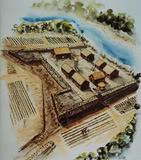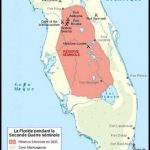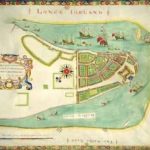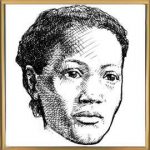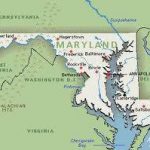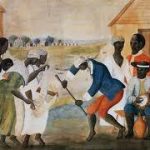First Free Black Settlement in North America
Image: Artist’s rendering of Fort Mose
Exploiting its proximity to plantations in the British colonies in North America and the West Indies, King Charles II of Spain issued the Edict of 1693, which stated that any male slave on an English plantation who escaped to Spanish Florida would be granted freedom provided he joined the Militia and became a Catholic. This edict became one of the New World’s earliest emancipation proclamations. Spanish rules about slavery were very different from those of the English. Spanish slaves could own property, could buy their freedom, could sue their owners and separating families was prohibited.
Word of the Spanish policy of giving sanctuary to escaped slaves spread rapidly among the black population in the Carolinas and Georgia, and the number of escapees steadily increased. By 1738, more than 100 Africans had reached St. Augustine, prompting the Spanish to establish Fort Mose (pronounced Moh-Say) and a nearby community named Gracia Real de Santa Teresa de Mose, two miles north of St. Augustine, Florida. The settlement included a four-sided fort, houses and fields.
Thirty-eight households of men, women, and children – mostly runaways from the Carolinas – lived at Mose. Fort Mose was a diverse community made up of Africans from widely varied backgrounds: Mandingos, Congos, Carabalis, Minas, Gambas, Lecumis, Sambas, Gangas, Araras, and Guineans. Many were skilled workers, blacksmiths, carpenters, cattlemen, boatmen, and farmers, and they created the first legally-sanctioned free black community in what is now the United States, which ultimately attracted other fugitive slaves.
A free black militia was formed in 1738, headed by Francisco Menendez, an escaped slave who had achieved the rank of Captain in the St. Augustine militia. The original fort was a small, twenty-meter-square enclosure containing a watchtower, a well, and a guardhouse. With three walls made of earth, stakes, and cactus, the fort was surrounded by a shallow moat.
The Battle of Fort Mose
War between Spain and Britain was declared in September 1739. The North American colonies became involved when General James Oglethorpe, founder and governor of the new British colony of Georgia, marched on St. Augustine in May 1740. He brought a combined force that included the British 42nd Regiment, the Highland (Scottish) Independent Company Foot, South Carolina Militia, Georgia volunteers, and Indian allies.
At the approach of Oglethorpe’s troops, the inhabitants of Fort Mose were evacuated to the safer St. Augustine. An English militia – mostly farmers seeking their runaway slaves – occupied Fort Mose as a base to fight from. Other British troops settled in on Anastasia Island to bombard Castillo de San Marcos, a large stone fort that guarded St. Augustine from sea attacks.
On June 14, 1740, Mose’s men returned with some Spaniards to reclaim their fort. They ambushed the sleeping intruders at four o’clock in the morning, beginning what the British called Bloody Mose. The death count varies from witness to witness, but by the end of the attack, the fort was burned and the English survivors ran home. Francisco Menendez was commended for his valor and leadership.
The rest of Oglethorpe’s troops continued to assault St. Augustine from the harbor, but the Mose ambush turned the tide. The Spaniards and Africans stood their ground from the Castillo until Cuban reinforcements sent Oglethorpe retreating back to Georgia.

Image: Fort Mose Soldier
Second Fort Mose
The Fort Mose settlers lived inside St. Augustine until 1752, when their fort and town were rebuilt. The site included a church, a house for a priest, a well, a lookout tower. The villagers attended Mass, farmed the land, and the men stood guard at the fort or patrolled the frontier. The Mose militia continued to distinguish itself in skirmishes with British colonists. In 1759, the village consisted of twenty-two palm thatch huts which housed thirty-seven men, fifteen women, seven boys, and eight girls.
The residents of Fort Mose prospered there until 1763, when Florida was ceded to Britain by treaty. The Africans retained their freedom by accompanying the Spaniards to the northwest coast of Cuba. There, they re-established their community as Ceiba Mocha in Matanzas province.
Designated a National Historic Landmark in 1994, Fort Mose is now the premier site on the Florida Black Heritage Trail, a tangible reminder of the people who risked and often lost their lives in their struggle to attain freedom.
SOURCES
Black History
Fort Mose (Florida)
African Americans Settle at Fort Mose
Fort More History: The Patriot War
Fort Mose: America’s Black Colonial Fortress of Freedom
